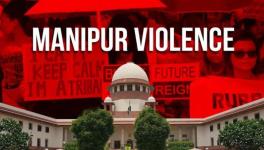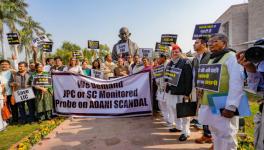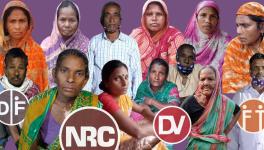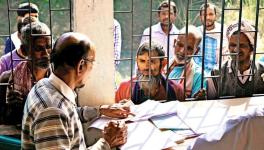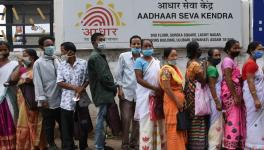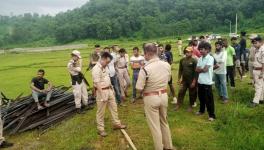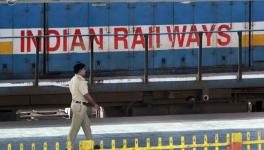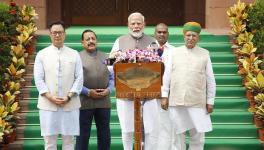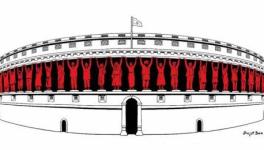Assam Election: Can Sops and Promises Overcome Discontent?
Representational use only.
With Assembly elections around the corner in Assam, the political battle-lines are getting drawn. Disparate regional aspirations, especially those of the tribal communities in the Bodo region, are likely to reflect strongly on these poll results.
In December, the BJP and the newly-formed United People’s Party Liberal (UPPL) formed the government in the Bodoland Territorial Council region. As a result, BJP’s former ally, the Bodoland Peoples Front or BPF, has started campaigning independently on all seats in Bodoland for the upcoming Assembly election.
This election also comes against the backdrop of the third Bodo Accord. The ruling party has been promising that the peace accord will end uncertainty and violence in the region, although it has already split the BJP and BPF, who had been allies since 2016.
Further, BPF has joined hands with the Congress-led Mahagathbandhan for the state elections. However, even the UPPL has been raising its dissatisfaction with the progress on multiple issues of concern to the tribals in particular.
For example, the high dropout rate among tribal schoolchildren, lack of awareness among adults, widespread illiteracy and the consequent inability to access government entitlements and jobs has deprived people of the fruits of development.
“When the BJP came to power there were high expectations from them but the Santhal and other communities of Assam have not got any benefits. Now we are trying to take a strong stand for the community. For example, Santhali language is recognised in the Eighth Schedule of the Constitution, but Santhal teachers’ posts are yet to be filled,” says Wilson Hansda, a governor-nominated member in the BTC, who is one of the two lakh Santhalis in the state and a member of the UPPL.
This author traveled through villages in Bodoland, including Kokrajhar, Saralpara, Kachugaon, Gossaigaon, Bonaigaon, and Saraibil to gauge the ground situation and followed up with people in the region in light of the coming polls. It is evident from these that the tribal communities have varied politicial demands and allegiances, and that there is likely to be a shifting of loyalties in these polls. For instance, in many Santhal villages, people no longer speak Santhali and are comfortable in Assamese, which is growing cause of concern.
The Santhal leaders Debilal Hembro and Palton Kisku say they are “worried” about Santhali culture disappearing and say they are attempting to make Santhali people aware of their language and culture. Leaders of the All Santhal Student Association (ASSU) also told this author that they have concerns related to the medium of instruction in schools, their demand for Scheduled Tribe status, and the appointment of teachers from the community in primary schools of Santhal villages.
The Santhal, Oraon, and Munda communities come under the category of Other Backward Classes in Assam. There is also a demand for Scheduled Tribe status from the more than 36 “tea tribes” of Assam along with five other communities, Tai Ahom, Koch Rajbongshi, Chutiya, Moran, and Motok. Their inclusion is under consideration.
The region’s Santhal community has in the past supported the Congress, the BPF, and the UPPL. In the coming polls, they are expected to support the BPF in some Santhali pockets of the Bodoland Territorial Council region.
However, the Santhal community is segregated along multiple organisations and leaders, which makes taking a united position a challenge for its leaders. On its part, the UPPL has been conducting preliminary discussions with the student body, Santhal Sahitya Sabha, and the ceasefire groups of the Santhal community. “However, the dialogue between the ceasefire group and ADGP (Additional Director General of Police) has not gone forward yet,” Hansda says.
In effect, there are two new political outfits in the fray, which will play a vital role in this election. In the Bodoland Territorial Region, UPPL is in a position to help the ruling party, but in Upper Assam it will have to rely on ‘packages’ and rejigged autonomous councils. Besides, the split with BPF will help BJP’s rivals in the state.
Background and relevance
Bodoland includes the four districts of Kokrajhar, Chirang, Udalguri, and Baksa in western Assam, surrounded by Bhutan in the north and Bangladesh in the southwest. The Bodo community is considered one of the oldest and largest out of the 34 tribal communities in Assam. They have been demanding greater political autonomy since the early decades of Independence. Several groups supported separatism and there were demands for a new state.
The BTC receives grants from the Centre and Assam government. Now, the Bodoland Territorial Area District will be renamed Bodoland Territorial Region to emphasise Bodo identity. The 46-member BTC will expand to 60 to give more representation to the Bodo people. The state government will also set up a Boro-Kachari Welfare Autonomous Council for the development of Bodo villages outside the BTAD region, on lines of the existing councils for plains tribes.
The state will also consult Bodo organisations and councils before notifying areas to be included in the proposed Bodo-Kachari Council. There is also a new provision to include villages with a majority of Bodo community residents and exclude villages of non-tribal populations.
The youth of the region see the third accord as an important development, for it got rebel groups to give up arms and many leaders to join or float political outfits. However, there are undercurrents of demands and aspirations that remain unfulfilled. For example, in the upcoming election, the UPPL has decided to strongly pursue its demand for Scheduled Tribe status for the Santhal people. “The BJP is in power in the state and at the Centre, so we are trying to convey this demand through the state government,” says Hansda.
The state government has formed a Group of Ministers which is supposed to send a report to the Centre on the demand for Scheduled Tribe status for the six communities, but its recommendations are not known yet and the report has not been sent to the Centre. From the perspective of the BTC leaders, it amounts to promises, but nothing done.
In January last year, two more organisations had surrendered with the signing of the Accord; the Adivasi Tiger Fighters and the National Santhal Liberation Army. At the time, these groups were assured rehabilitation towards living a normal life, but the government has not taken any steps in this regard yet. Now, the UPPL has been advocating this demand to the state and central governments. Its leaders have been visiting the Union Home Ministry and its northeast affairs’ pointspersons. “Till date, there is no positive outcome nor initiative though we are trying to get the things done,” Wilson says.
Understanding other communities
Kansai Bramha, who did his Masters from the Tata Institute of Social Sciences and is currently working with an NGO, says, “Bodo people do not have any objection [to the inclusion of six more groups in the Scheduled Tribe list] unless their own reservation is violated.” He acknowledges the concern of some other communities, which are socially and economically backward, and therefore must get the benefit of reservations.
The second-highest population in Assam, around 34%, is the Muslims. For the last few years, there have been violent clashes between members of other communities and Muslims. Ajibor Rahman said that a BJP minister said during the recent election campaign, “Mughalon ko hame harana hai aur unhe yaha se hamesha ke liye bhagana hai—we have to defeat ‘Mughals’ and chase them out from here.’
In his book Great Game East, published by Yale University Press in 2015, Bertil Lintner writes that Assam still has some of the most fertile agricultural lands, which has attracted economic migrants from the sub-continent especially Bangladesh. An estimated five million Muslim Bengalis are said to have fled to Assam in the wake of the Liberation War. Lintner pointed out that this had the militant student movements spark fears that the politics of the region would change, causing bloodshed and making the Muslims who already lived there vulnerable.
Leaders of the All Minority Student Union (AMSU) reported that it is unhappy with the state government’s recent decision to close down madrasas and expressed anguish that members of other communities always see them as “Bangladeshi” Muslims. District President Mazharul and District secretary Bodiar Hussain, however, clearly say they do not want Bangladeshi migrants and express fears that Hindus who migrated from Bangladesh would gain Indian citizenship in the new CAA-NRC exercise.
Even the Bodo community has raised the concern of its language and culture dying out. The Bodo Sahitya Sabha was formed in the early sixties as the sole institution to develop the language, which is one of the 22 languages listed in the Eighth Schedule. Sahitya Academy awardee Bodo writer Jwishiri Boro expressed distress over there being no publishing houses in the Bodoland region.
She had self-published her book, Jiu Saharani Bed, for which she won the Young Sahitya Academy award in 2011. “Though there are young Bodo-language writers, they lack readers. Readership needs to be widened for enrichment of language itself, ” she said.
Historian Sanjib Baruah has highlighted in his book, India Against Itself, published by Oxford India Paperbacks in 1999, that the historical construction of Assamese nationality has been challenged in recent years by groups such as the Bodo, Karbi, and Mising, who, though labeled the “plains tribal” constituents of a composite Assamese nationality until recently, are increasingly seeking an autonomous political future.
Environment challenges
Parts of Bodoland are dense forests famous for rich woods. While going to Saralpara, around 70 km from Kokrajhar and adjacent to the Indo-Bhutan foothills, it is apparent that there has been a complete burning and cutting of forests to meet demands for housing and agriculture. This used to be an abode of the golden langur and elephants but the construction and new settlements have pushed the animals into Bhutan.
The Kokrajhar District Forest Officer showed this writer a 2005 map of the forested area. According to him, more than 30% of the forest cover has been depleted since then. The reason, he said, is pressure from political groups and pressure from the local government to find housing and agricultural land. Between 1977-2007, the rate of growth of the population was steadily decreasing in the district, while the rate of deforestation would fluctuate. The district lost 38% of its forest cover at the beginning of this period.
Statisticians and environmentalists DC Nath and DD Mwchahary recorded in their 2012 study, “Deforestation and Transition of Tribal Population: A Study in Kokrajhar district of Assam, India,” that if deforestation continues at recent rates, even if the population growth rate remains stable, Kokrajhar would lose 43.5% of the forest cover it had in 2007 by the 2030s.
Challenges and growing aspirations
The Bodoland region lacks employment opportunities, so most youths seek jobs and migrate all over the country. However, during the BTC election, parties had enthusiastically rallied people from all walks of life and all communities. This is the sign of a healthy democracy, so long as all these voices are heard in the rest of India. There needs to be space for regional identities and peoples’ aspirations must be heard.
Prime Minister Narendra Modi has said that his government abides by “Look East and Act East”, and the 2020 Accord does renew hope, but attitudes towards the region must shift away from the conservative mould. “Cooperative Federalism” should not remain merely an idea, it needs to be executed. Regional voices should not be sidelined in the overpoweringly centrist tendencies and challenges of the region must be tackled with local governance and, where needed, with state-Centre coordination. The autonomy of ethno-national identities should not be viewed as a danger to national integrity.
The author is a Masters student in Dalit and Tribal Studies at the Tata Institute of Social Sciences Mumbai. He acknowledges the assistance of Kansai Bramha, Mijink Bramha, Bajun Hembrom and Ajobor Rehman of the North East Research and Social Work Networking in doing this field work. The views are personal.
Get the latest reports & analysis with people's perspective on Protests, movements & deep analytical videos, discussions of the current affairs in your Telegram app. Subscribe to NewsClick's Telegram channel & get Real-Time updates on stories, as they get published on our website.









